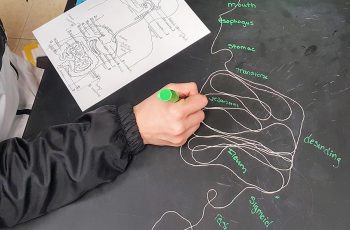Search results for: “biologycorner.com”
-

Modeling the Alimentary Canal
In this activity, students use string to model the gastrointestinal tract as a scale model. I’ve noticed that students do have difficulty with the concept of scaling, which is one of the crosscutting concepts listed in the NGSS. The directions give students measurements for a 1/3 scale model, the human alimentary canal is about 9…
-

Investigation: Gel Electrophoresis and DNA
This procedural lab is a great compliment for genetic studies where students learn about sex linked genes and mutations. The allele for Duchenne Muscular Dystrophy is located on the X chromosome and is associated with a deletion mutation for that region.
-

Case Study: How Do Tibetans Survive High Altitudes
Based on the Berkeley website: Understanding Evolution, this version focuses on the how the body maintains homeostasis at high altitudes. This involves increased production of red blood cells to improve oxygen supplies to tissues. Tibetan populations have adapted to high altitudes by producing fewer red blood cells which improves fetal mortality rates. Case looks…
-

Data Analysis: Funky Juncos
View a short video about how a group of birds split from the main population and evolved in relative isolation near a college campus. The film is is 88 minutes long and all of its parts can be viewed at the Juncoproject.com, though for this activity, only one 16 minute chapter is viewed. The…
-

Data Analysis: Virginia Opossum and Color Variations
Students examine scatter plots that show phenotype variations among opossums in North America, exhibiting variations in coat color, ear length, and size.
-

Investigation: Gene Switches in Stickleback Fish
This activity was modified from HHMI’s “Modeling the Regulatory Switches of the Pitx1 Gene in Stickleback Fish” The activity is presented as a type of investigation or case study where students examine regulatory switches and was a short film that describes the role of the Pitx1 gene in the development of spines. Students can work…
-

DNA, Proteins, and Sickle Cell
In this activity, students use a codon chart to compare the DNA sequence of HbA (normal hemoglobin) to HbS (sickle cell). The DNA differs in a single base, where the codon for normal hemoglobin codes for glutamine, and the mutant form codes for valine.
-

Dog SNPs and Curly Hair
In an effort to add more real data to the DNA (genetics) unit, I added a shortened form of the HHMI activity: “Mapping Genes to Traits in Dogs Using SNPs” The activity on HHMI is too advanced for freshman level biology, but I thought it would be a good introduction to DNA sequences. The activity…
-

Genetic Crosses with 2 Traits with Rabbits
Beginning biology students can struggle with dihybrid crosses and setting up Punnett squares that have two traits. When tackling this concept, make sure students are familiar and competent with basic genetic crosses and setting up Punnett squares for a single trait. For example, a tall (Tt) plant is crossed with a short plant (tt). Once…
-

What Happened to Virtual Dissections?
Many of us may have used virtual dissection platforms to supplement classroom activities or provide make-up work for students who missed lab days. Unfortunately, many of the platforms for virtual dissections were created using flash animation. Web browsers no longer support flash, mainly because they create security risks. Viruses and malware can be delivered through…
-

Sheep Heart Dissection
Students use this dissection guide to learn the anatomy of the heart, using a sheep as a model. The sheep heart is similar to a human, and students can identify the major vessels: aorta, pulmonary artery, pulmonary vein, and the vena cava. The guide includes instructions on how to determine which side of the heart…
-

Model the Digestive System with Coloring
The digestive system is a series of organs that work together to break down food into nutrients that the body can use. The digestive system includes the mouth, esophagus, stomach, small intestine, large intestine, rectum, and anus. Coloring activities can be helpful to give students a chance to model the organ systems. I short, coloring…
-

DNA, Proteins, and Mutations
Students explore how DNA becomes a function protein by using a codon chart to transcribe and translate a gene. They compare the gene found in humans to that found in other animals, deducing that the genes are very similar with only slight changes. Finally, students examine the different types of mutations and how a…
-

Evolution: Fact, Fiction, or Opinion
This lesson can be used to introduce evolution and establish what your students already understand (or misunderstand) about evolutionary theory. Statements can be printed and cut into slips and students work in small groups to categorize each statement as either Fact, Fiction, or Opinion. The included answer key has quick explanations as well…


